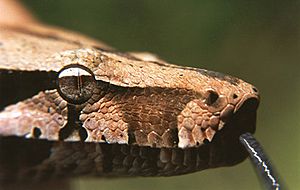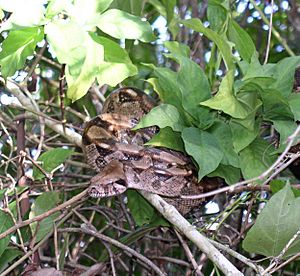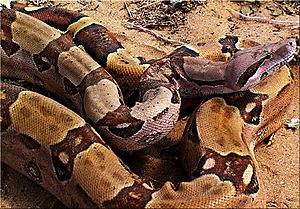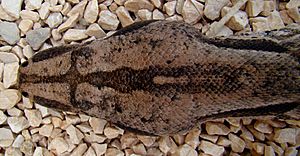Boa constrictor facts for kids
Quick facts for kids Boa constrictor |
|
|---|---|
 |
|
| Scientific classification | |
| Kingdom: | |
| Class: | |
| Order: | |
| Family: | |
| Genus: |
Boa
|
| Binomial name | |
| Boa constrictor Linnaeus, 1758
|
|
The Boa constrictor is a large, non-venomous snake. It lives in Central America, South America, and some Caribbean islands. What's cool is its common name is the same as its scientific name! These snakes have amazing skin patterns that help them blend in. They can grow very big. There are ten different types, or subspecies, of boa constrictors.
Contents
Discovering the Boa Constrictor
How Big Do Boa Constrictors Get?
The size of adult boa constrictors changes depending on their subspecies. It also depends on where they live. The biggest ones are often found in northern South America.
Female boas are usually larger than males. They are longer and thicker. Most adult female boas are about 2.1 to 3 meters (7 to 10 feet) long. Males are a bit smaller, usually 1.8 to 2.4 meters (6 to 8 feet) long. In captivity, some females can grow even bigger, reaching 3.6 to 4.2 meters (12 to 14 feet).
What Do Boa Constrictors Look Like?
Boa constrictors have brownish bodies. Their tails often turn a brick red color. This coloring helps them hide very well in the jungles and forests where they live. It's a perfect camouflage!
Their backs have large, tan-colored patterns that look like saddles. These patterns get lighter towards the tail. On the tail, the patterns become pale cream half-rings. These stand out brightly against the red tail. This is why many people call them "red-tailed boas."
Sometimes, boas are born with different colors. This happens because of a genetic change. For example, some can be albino, meaning they lack color. These special color types are rare in the wild. But people often breed them in captivity to create many beautiful "morphs," or color variations.
Special Features of Boas
Boas have a special tail that can grab onto things. This is called being prehensile. It helps them climb and hold onto branches. They can also sense heat using special cells in their lips. This helps them find warm-blooded prey, even in the dark.
Boa constrictors also have two lungs. One lung is much larger and works well. The other is smaller and doesn't work as much. This helps their long bodies fit their organs better.
Where Boa Constrictors Live

Boa constrictors live in many places. You can find them across Central America. This includes countries like Belize, Guatemala, and Panama. They also live in South America, in countries like Colombia, Brazil, and Argentina. You can even find them on some Caribbean islands.
These snakes can live in many different environments. They are found in hot, wet rainforests. They also live in dry, semidesert areas. However, they prefer rainforests. This is because rainforests offer good humidity and temperatures. They also provide lots of places to hide and plenty of food.
Boa constrictors are good swimmers. They are often found near rivers and streams. They also like to hide in the burrows of medium-sized mammals. These burrows keep them safe from other animals that might try to hunt them.
How Boa Constrictors Behave
Boa constrictors usually live alone. They only interact with other snakes when it's time to mate. They are mostly active at night. But sometimes, they will bask in the sun during the day. They do this if the night temperatures are too cold.
Young boas often climb trees and bushes to hunt. This is called being semi-arboreal. As they get older and heavier, they spend more time on the ground. This is called being terrestrial.
Boas will strike if they feel threatened. Their bite can hurt, especially from a large snake. But it is rarely dangerous to humans. Boas from Central America can be more easily annoyed. They might hiss loudly and strike many times. Boas from South America tend to be calmer.
Like all snakes, boas are more unpredictable when they are shedding their skin. During this time, a substance makes their eyes look milky or blue. This means they can't see very well. Because of this, they might be more defensive than usual.
Hunting and Eating Habits
Boa constrictors eat many different small to medium-sized animals. Their diet mostly includes rodents. But they can also eat larger lizards and even small mammals like ocelots. Young boas eat small mice, birds, bats, lizards, and amphibians. As they grow, they eat bigger prey.
Boas are ambush predators. This means they often wait quietly for prey to come near. Then, they attack quickly. However, they sometimes actively hunt, especially if there isn't much food around. This usually happens at night.
First, the boa strikes and grabs the prey with its teeth. Then, it wraps its body around the prey. It squeezes, or constricts, until the prey stops moving. Scientists used to think snakes suffocated their prey. But now we know that constriction stops blood flow to the heart and brain. This causes the prey to become unconscious and die very quickly.
Their teeth also help them pull the animal down their throat. Strong muscles then move the food towards the stomach. It takes about 4 to 6 days for the snake to digest its meal. This depends on the size of the food and the temperature. After a big meal, a boa might not eat for weeks or even months. This is because they have a slow metabolism.
Boa Constrictor Babies
Boa constrictors are viviparous. This means they give birth to live young, not eggs. They usually breed during the dry season, from April to August. Males can mate with several females.
The mother carries her babies for about 100 to 120 days. Then, she gives birth to young snakes. Each baby is about 38 to 51 centimeters (15 to 20 inches) long. A mother can have anywhere from 10 to 65 babies at once. The average is about 25.
The baby boas are independent right after birth. They grow very fast for their first few years. They shed their skin often, usually once every one to two months.
Boa Constrictors as Pets
This snake species does very well in captivity. They often become quite tame. You can see them in zoos and in private reptile collections. Many boa constrictors are now bred in captivity. This helps reduce the number taken from the wild.
In captivity, they are fed mice, rats, rabbits, and chickens. The size of the food depends on the snake's size and age. Boa constrictors can live a long time as pets, usually 20 to 30 years. Some have even lived over 40 years! This means getting a boa as a pet is a big, long-term commitment.
The oldest boa constrictor recorded in captivity was named Popeye. He lived for 40 years, 3 months, and 14 days. He died at the Philadelphia Zoo in 1977. To keep a boa healthy and living long, they need proper care. This includes enough space, the right temperature and humidity, and suitable food.
Importance of Boa Constrictors
Boa constrictors are very popular in the exotic pet trade. Many are bred in captivity, but some are still caught from the wild. In the past, many wild boas were imported into the United States. This put a lot of pressure on wild populations.
People also hunt boa constrictors for their meat and skins. You can often see them at markets in the areas where they live. After the reticulated python, boa constrictors are the most common snake used for snakeskin products. These include shoes, bags, and other clothing items.
In some places, boas help control the number of opossums. This is important because opossums can spread diseases to humans. In other areas, boas are sometimes released into communities. They help control rodent populations, which can be a big problem.
Protecting Boa Constrictors
All boa constrictors are protected under CITES. This is an international agreement to protect endangered plants and animals. Most boa constrictors are listed under CITES Appendix II. This means their trade is controlled to prevent them from becoming endangered. One subspecies, B. c. occidentalis, is listed in CITES Appendix I. This means it is more endangered, and its trade is very strict.
In some places, human hunting and other animals have greatly reduced boa numbers. Also, too many have been collected for the pet and snakeskin trades. However, most populations are not in immediate danger of extinction.
Boa constrictors might also be an invasive species in Florida. This means they are not native to the area and could harm the local environment.
Images for kids
See also
 In Spanish: Boa constrictora para niños
In Spanish: Boa constrictora para niños






